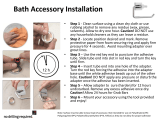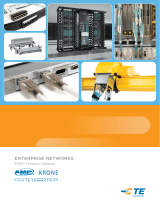Page is loading ...

7/16” OD Rod
Since 1956
OPERATION AND SAFETY MANUAL
Trace Underground Pipe Without Digging
- Less Disruption To Roads And Landscapes
- Minimal Pavement Breakage, Excavation, Restoration
Connect a signal transmitter to the Duct Hunter™ to energize unit
with a specic frequency. When rod is pushed into underground
pipe, signal radiates outward where a receiver detects frequen-
cy, allowing utility pipe to be traced from above ground.
• Trace to depths up to 10’
• Locate sewer laterals to conrm no cross bore has occurred
• Locate ductile iron, plastic, tile or concrete pipe
• Rod marked in 5’ increments
• 9” Bend radius
Jacket Core Wire
Warranty
Jameson products carry a warranty against any defect in material and workmanship for a period of one year from date
of shipment unless failure is due to misuse or improper application. Jameson shall in no event be responsible or liable for
modications, alterations, misapplications or repairs made to its products by purchaser or others. This warranty is limited
to repair or replacement of the product and does not include reimbursement for shipping or other expenses incurred.
Jameson disclaims any other express or implied warranty.
Duct Hunter
Rod
Diameter
Rod
Length
Recommended
Conduit Size
13-716-400M 7/16” 400’ 4” or Larger
13-716-500M 7/16” 500’ 4” or Larger
13-716-600M 7/16” 600’ 4” or Larger
13-716-800M 7/16” 800’ 4” or Larger
13-716-1000M 7/16” 1000’ 4” or Larger
• Wear safety glasses and gloves.
• Keep rod inside reel when not in use. Out-of-control rod can harm personnel or property.
• Keep rod clean. Some contaminants (including water) can conduct electricity.
• Keep secure footing. Protect yourself from falling should pulling eye move suddenly or separate from rod.
• Check for rod damage prior to use. Cracks, gouges, nicks, or white stress marks on jacket or sharp bends will weaken rod.
Injury could result if rod breaks while pulling.
• Do not use slip joint pliers, locking pliers or powered pulling equipment on rod.
• Do not force a pull that is stuck. Check for kinks or obstructions.
• Avoid pulling rod over sharp edges.
• Do not bend rod beyond 9” radius.
Do not use on live circuits. Electric shock may result. The Duct Hunter is equipped with a metal tip and
continuous internal copper wire. Do not use on or near live circuits. Electric shock may occur.
WARNING - ADHESIVE
Read manufacturer’s instructions before using adhesive. In case of eye contact, ush with water and seek medical atten-
tion If skin contact occurs, apply solvent (such as nail polish remover) to area and gently remove adhesive. Wash solvent
off with water. Solvents should not be used in case of contact with eyes or open wounds.
Always wear safety goggles (ANSI Std. Z87.1) and gloves when working with adhesive and/or unprotected berglass rod.
See adhesive product label for Safety Data Sheet (SDS).
Rod Is Marked In 5’ Increments
Add “MM” To Part Number For Metric Marked Rod
Add AWK To Part Number For All-Terrain Wheels

Accessory Kit (Included)
Part No. 13-716-AK
Qty
1 Roller Guide
1 End Ferrule
1 Splice Ferrule
2 Adhesive
2 Emery Cloth
1 Shrink Tube
1 Canvas Storage Pouch
(Mounts On Reel)
Part Number
Accessories - Available Separately
13-716-AK Accessory Kit
Roller Guide, End Ferrule, Splice Ferrule, 2 Adhesive, 2 Emery Cloth, Can-
vas Pouch
9-141 Roller Guide
Guides rod through bends, sweeps, misalignments and wires; Increases
contact with pipe on lead end of rod to improve overall signal strength
9-171
Roller Guide with
Spring Adapter
Heavy duty spring permanently attached to swivel roller guide helps push
rod past difcult bends or debris in pipe
9-139 Swivel Eye Attaches pull line to rod
13-146 End Ferrule Repair Kit End Ferrule, Adhesive, Emery Cloth, Instructions
13-140 Splice Repair Kit Splice Ferrule, Adhesive, Emery Cloth, Instructions
11-AWK Wheel Kit All-Terrain Wheel Kit (2 wheels/axle)
14-169 Sonde Sonde, Operates at 512 HZ, 1/4-20 Female Thread. .12 lbs, 2.25” X .75”
9-169 Sonde Adapter
Heavy Duty Flexible Adapter with Chain, Fits 3/8” and 1/2” Buddy Rod-
ders; 5/16”and 7/16” Duct Hunters. Fits 14-169 Sonde.
9-170 Sonde Adapter Solid Adapter, Fits Sonde and 3/8”, 1/2”, 5/16”, 7/16” Rod
12-170 Sonde Adapter
Solid Double Female Adapter, Fits 3/8”, 1/2”, 5/16”, 7/16” Rod and M-10
Male Sonde
12-165
Sonde With Flexible
Adapter
Kit: Sonde 14-169 and Adapter 9-169
Accessories
800.346.1956 WWW.JAMESONLLC.COM Clover, SC
9-171 Roller Guide with Spring Adapter
11A-AWK Replacement All Terrain Wheels
12-165 Kit: Adapter 9-169 & Sonde 14-169
Solid Adapter 9-170Double Female 12-170

1. Operates in upright or horizontal position. If used in horizontal position, safety roller guides and brake
control handle should be on top side.
2. Set drag brake to highest amount of drag (Fig. 1).
3. Insert end of berglass rod between the upper and lower nylon safety roller guides (Fig. 2).
This ensures duct rod will be safely contained while working with it.
4. Release pressure on drag brake handle so rod will begin to slowly payout from reel.
5. Brake may be set for constant drag on payout of rod. The constant drag makes one-man operation
possible. Fully tightening brake handle stops payout of rod. For constant drag and controlled payout,
set brake handle where reel turns only as you pull out rod.
6. Pay out rod into underground facility. Lock brake handle.
7. Attach signal output lead from your transmitter to brass end ferrule on clip attachment (Fig. 3).
Attach ground lead to desired ground mechanism.
8. Follow your transmitter’s operating instructions to apply the desired signal frequency to the rod.*
9. Use your receiver to trace the path of the rod following the instructions of your receiver.
10. If further rod payout is required, detach transmitter output lead, loosen drag brake and pay out
more rod. Lock brake handle and re-attach transmitter output lead.
11. When recoiling rod, detach transmitter lead, loosen drag brake and push rod back onto reel. Allow
reel to spin only when pushing rod. Do not manually spin reel in an attempt to reel up rod.
* Always follow the manufacturer’s instructions and precautions when using your transmitter and re-
ceiver. Jameson is not responsible for damage or injury as a result of improper use of your transmitter or
receiver.
Duct Hunter Operation
Drag Brake
Roller Guides
Transmitter Lead On
Clip Attachment
(Fig. 1) (Fig. 2) (Fig. 3)

DH716_MO6
Splice Repair
End Ferrule Repair
Fig. 1
Fig. 2
Red Jacket
Fiberglass Core
Fold Wire Back
Along Flat Portion
1”
Red Jacket
Fiberglass Core
Copper Wire
1”
1”
1. Cut away damaged section(s) of rod with a ne-tooth hacksaw,
cable cutter or sharp knife. With pipe cutter and/or sharp knife, strip red
protective jacket back from berglass core approximately 2”. Do not
cut berglass core when stripping jacket. Do not crush berglass core.
2. Once jacket is removed, use pipe cutter again to score a mark
around berglass core approximately 1” from edge of jacket. Use sharp
knife to carefully strip away 1” of berglass core closest to rod end to
expose copper wire. Be careful not to damage wire. The 1” portion of
rod closest to jacket will remain intact (Fig.1).
3. Using sharp knife, strip away a at spot on remaining 1” portion of berglass
core approximately as deep as wire diameter (.04”). Cut exposed wire length
to approximately 1” and lightly strip away thin coating on copper wire. Fold
wire back along at spot in berglass core (Fig. 2).
4. Attempt a test t of replacement ferrule over exposed berglass core with
wire folded back. It should be rm and snug with little or no play to assure
wire contacts inside of ferrule. If too loose, cut away rod end and repeat
Steps 1-4.
5. Once proper t is established, install end ferrule without adhesive and
check for continuity of the internal copper wire using a digital multimeter.
Touch a probe to end ferrule at each end of coiled rod. Any resistance
reading (generally between 2-12 ohms) indicates proper continuity.
6. Remove end ferrule. Clean rod end and ferrule with cleaning solvent
or alcohol to remove debris and glass bers. Allow solvent to completely
evaporate. Step 6 is extremely important.
7. Mix and apply adhesive to entire surface of berglass core and wire.
Insert rod into ferrule as far as possible, enclosing end of red jacket in
counterbore of ferrule. Wipe away excess adhesive.
8. Check rod again for continuity using digital multimeter. The adhesive
will not set for 20 minutes. If no continuity, remove ferrule, clean off
adhesive and repeat steps 1-7.
Splicing: Follow steps 1-8 for both ends of rod being spliced. Use splice ferrule instead
of end ferrule. Before inserting prepared rod ends into splice ferrule, slide piece of heat
shrink tubing over one rod end and move it along rod out of way.
Once a proper splice is obtained, wait at least 20 minutes for adhesive to set. Move
heat shrink tubing over splice ferrule so it is completely covered. Use heat gun or blow
torch to carefully shrink tubing, starting in center and working toward each end. Wipe
away any adhesive that oozes from the heat shrink tubing.
Repaired or spliced rod should be allowed to cure 24 hours prior to use.
Splicing Rod or Attaching New End Ferrule
WARNING - ADHESIVE
Read manufacturer’s instructions before using adhesive. In case of eye contact, ush with water and seek
medical attention If skin contact occurs, apply solvent (such as nail polish remover) to area and gently
remove adhesive. Wash solvent off with water. Solvents should not be used in case of contact with eyes or
open wounds.
Always wear safety goggles (ANSI Std. Z87.1) and gloves when working with adhesive and/or unprotected
berglass rod. See adhesive product label for Safety Data Sheet (SDS).
800.346.1956 WWW.JAMESONLLC.COM Clover, SC
/



